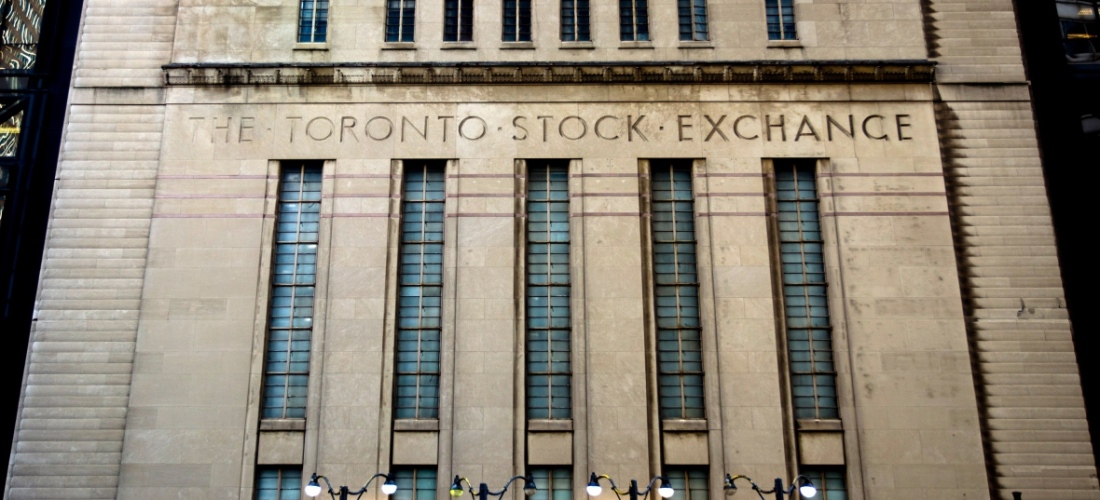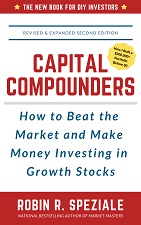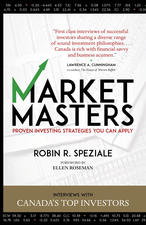![]() Subscribe Now to My Newsletter (Join 5,000+ Subscribers!)
Subscribe Now to My Newsletter (Join 5,000+ Subscribers!)
I love finding capital compounders; those stocks in the small-cap and mid-cap space that eventually grow into large-caps, on the foundation of their exceptional wealth creating ability, fueled by expanding book value per share, earnings per share, and free cash flow per share. The challenge, though, is finding these capital compounders when they’re small. As Peter Lynch said: “The person that turns over the most rocks wins the game.”
*** Email Me Now for a FREE copy of my new book – Capital Compounders ***
But what are the commonalities of capital compounder stocks?
Capital Compounders are:
- Free cash-flow generative, high return on capital (ROIC) businesses;
- Run by exceptional, and shareholder-oriented, managers who;
- Effectively deploy capital, to grow their business, and continually deliver high rates of return for their shareholders
The list below (as at April 10, 2017) is of 25 exceptional canadian capital compounders, many of which I hold in my own stock portfolio [NOTE: In July 2018, I added 15 more ‘Capital Compounder’ Stocks. See the blog post, and list below]. They’re all still publicly traded on the TSX. You can download the full spreadsheet of these 25 Canadian Capital Compounder Stocks (download: Canadian Capital Compounders – Robin Speziale – Market Masters – 2017), which includes the Company, CEO / Founder, Return on Capital (last 5 years), Compound Annual Return, Cumulative Return, and Number of Years on the Market, for each of these stocks.
25 Canadian Capital Compounders (initial April 2017 list):
| Company | CEO / Founder | Compound Annual Return |
| CRH Medical | Edward Wright | 82.38% |
| Dollarama | Larry Rossy | 55.53% |
| New Flyer Industries | Paul Soubry Jr. | 43.33% |
| Computer Modelling | Ken Dedeluk | 41.80% |
| Constellation Software | Mark Leonard | 38.18% |
| Premium Brands | George Paleologou | 29.68% |
| Stella-Jones | Brian McManus | 26.92% |
| Alimentation Couche-Tard | Alain Bouchard | 26.78% |
| Tucows | Elliot Noss | 26.57% |
| Savaria | Marcel Bourassa | 25.13% |
| MTY Food Group | Stanley Ma | 22.25% |
| Gildan Activewear | Glenn J. Chamandy | 20.72% |
| Stantec | Robert Gomes | 20.34% |
| Pollard Banknote | Douglas Pollard | 19.94% |
| Richelieu Hardware | Richard Lord | 19.82% |
| CCL Industries | Geoffrey Martin | 18.09% |
| Metro | Eric R. La Flèche | 17.87% |
| Saputo | Lino A. Saputo Jr. | 17.66% |
| Lassonde Industries | Jean Gattuso | 16.77% |
| Canadian National Railway | Luc Jobin | 15.77% |
| TFI International | Alain Bedard | 15.38% |
| Photon Control | Scott Edmonds | 14.76% |
| Brookfield Asset Management | Bruce Flatt | 13.21% |
| Enghouse Systems | Stephen J. Sadler | 12.05% |
| Logistec | Madeleine Paquin | 10.30% |
(Click here for an update on these 25 Capital Compounders: ’17-18, YTD 2018 Returns)
These 25 ‘Capital Compounders’ Data:
- Average annual compound return: 26%
- Average ROIC (over 5 years): 16%
- Average public life (so far): 15 years
15 ‘Next’ Canadian Capital Compounders (July 2018):
| Company | Ticker | CEO | ROIC (TTM) | ROIC (5yr Avg) |
| Spin Master | TOY | Ronnen Harary / Anton Rabie | 31.6% | 46.5% |
| BRP | DOO | Jose Boisjoli | 30.9% | 29.1% |
| Sylogist | SYZ | Jim Wilson | 23.0% | 13.5% |
| Tecsys | TCS | Peter Brereton | 19.0% | 11.6% |
| Calian Group | CGY | Kevin Ford | 17.4% | 17.0% |
| Transcontinental | TCL.B | François Olivier | 16.3% | 10.9% |
| Sleep Country | ZZZ | David Friesema | 16.0% | 12.2% |
| Magna International | MG | Donald J. Walker | 15.9% | 17.6% |
| Kinaxis | KXS | John Sicard | 15.5% | 18.4% |
| Fairfax India | FIH.U | Chandran Ratnaswami | 14.5% | 13.8% |
| CGI Group | GIB.A | George Schindler | 12.6% | 12.1% |
| Great Canadian Gaming | GC | Rod N. Baker | 12.3% | 12.0% |
| FirstService | FSV | D. Scott Patterson | 11.3% | 5.4% |
| CAE | CAE | Marc Parent | 10.9% | 9.2% |
| Andrew Peller | ADW.B | John E. Peller | 10.4% | 8.8% |
*TTM = Trailing Twelve Months
(See the blog post on the additional 15 ‘Next Capital Compounders’)
These 15 ‘Next Capital Compounders’ Data:
- Average annual compound return: 23.3%
- Average ROIC (over 5 years): 15.9%
- Average public life (so far): 14 years
I explore Capital Compounder Stocks more; explain what makes them special, and how to find them, in my talk at the Fairfax Financial Shareholder’s Dinner (2017): “Capital Compounders Today: 25 Market Beating Stocks”. Read my talk. Or listen to my talk.
My New Book – Capital Compounders:
In Capital Compounders, Globe & Mail Best-selling Author Robin R. Speziale makes it easy for anyone to beat the market and make money investing in growth stocks!
*** Email Me Now for a FREE copy of Capital Compounders. ***
Robin R. Speziale shares his own journey building a $300,000 stock portfolio before 30 by investing in growth stocks or “capital compounders”. Those stocks that double, and then double again, and again, and again…on the stock market. Stocks like Amazon, Home Depot, and Apple that have achieved the “tenbagger” ($1 turns into $10), and then “100-bagger” status ($1 turns into $100). Robin discusses the commonalities of today’s market-beating growth stocks so that investors can endeavor to find the new emerging capital compounders now and in the future – whether that’s in 2017, 2020, or 2050.
Capital Compounders is for both beginners and seasoned investors. It’s entertaining (because finance can be dry), and includes lots of easy-to-learn lessons, tips, and strategies on growth investing that you can apply in the stock market to make money.
What you’ll learn in Capital Compounders:
- How you can turn $0 into $300,000 (and more) by saving, and investing in growth stocks. Robin Speziale shares how he built a $300,000 stock portfolio before 30
- What market-beating growth stocks (“capital compounders”) have in common and how you can find the next capital compounders in the stock market
- Actual examples of 10-bagger (10x return) and 100-bagger (100x return) stocks, including the top 30 super stocks from the past 30 years
- How Robin Speziale picks winning stocks, including sharing with you his personal growth stock watch list / portfolio
- 72 Rules on investing in stocks; winning in the market, managing a stock portfolio, avoiding losers, and more investing basics
- Growth investing strategies from top growth investors, including Peter Lynch, Philip Fisher, William O’Neil, and more
Email Me Now for a FREE copy of Capital Compounders.
More Information on Capital Compounder Stocks:
Pender Fund: “Compounders”
“Compounding is one of the bedrock concepts of investing – “the ability to generate earnings from previous earnings”1. For us, “Compounders” are those companies that can internally compound their intrinsic value at a mid-teens annualized pace or better for an extended period of time, for example a company growing its business at a mid-teens pace will typically double its intrinsic value every five years.” Read More.
Base Hit Investing: “Reinvestment Moat Follow Up: Capital Light Compounders”
“A couple of months ago John invited me to contribute a guest post to Base Hit investing (link) where I discussed the difference between Legacy Moats and Reinvestment Moats. While I encourage you to read the post for the full explanation, below is a quick summary…” Read More.
Financial Times: “Warren Buffett and the three ‘C’s’ of investment”
“Warren Buffett doesn’t like dividends. He believes the best way to return value to shareholders is by reinvesting profits back into a business. Despite Berkshire Hathaway being a tremendous generator of cash, it has almost never paid a dividend — the exception was in 1967 and Buffett jokes that he must have been in the bathroom when that decision was made.” Read More.
Financially Integrated: “The Attraction of Compounders”
“Businesses that can compound their income through ongoing reinvestment into their business are a rare breed. I explore why I like these businesses so much. I wanted to reflect on some material which I saw recently that was published in one of Berkshire Hathaway’s annual meetings. In that report Buffet commented that the best kind of business is one where there is the opportunity to reinvest capital at high rates of return over a long period of time. This business tends to produce the best long term investment results.” Read More.
Akre Capital Managment: “What is Compounding?”
“We think hard about the ingredients required for a business to compound in value over the course of many years. We believe these include: 1) an ability to generate above average returns on shareholders’ capital, 2) opportunities to deploy additional capital at above average returns, and 3) a management team with the skill and judgment to sustain the process of compounding over a long period of time in the face of competition. You’ll recognize this is just another way of describing our “three-legged stool” approach: Business, Management, Reinvestment.” Read More.
Investment Master Class: “Quality Companies, Compounders and Value Traps”
“Many of the great investors evolve over time to focus on high quality companies. In the post ‘Evolution of a Value Manager’ I outlined how Buffett, with insight from Munger and the acquisition of See’s Candy transitioned from seeking cheap companies [ie cheap PE/, price/book etc] to trying to purchase high quality companies at reasonable prices. Li Lu and Mohnish Pabrai are two Buffett disciples who have made a similar transition.” Read More.
Intrinsic Investing: “How Moats Make a Difference”
“In our writing here we’ve made clear the the single most important element of our investment approach is focusing on companies that have A WIDE COMPETITIVE MOAT. Usually when people talk about different kinds of moats, they are referring to the elements of the business model that give rise to the company’s competitive advantages. These concepts, like being the low cost producer, having proprietary intellectual property or exhibiting network effects, have been well documented by many writers. Morningstar’s book WHY MOATS MATTER offers an excellent overview. But just as important is the different types of opportunities that different types of moats can afford companies.” Read More.
Stockopedia: “The importance of return on invested capital and compounding”
“Return on invested capital, or ROIC for short, is just one of the many return on capital (ROC) metrics investors can use to determine the long-term future performance of a company. A high return on invested capital can be thought of as an ‘engine’ that drives company growth – as every pound of profit can be reinvested at this high rate of return. Indeed, ROIC has featured heavily in the writings of Warren Buffett, Joel Greenblatt, and even Ben Graham, to name a few. But there are, in reality, few companies that are able to achieve a strong, recurring ROIC, as a percentage of the overall stock universe.” Read More.
ArunsPlace: “Why were the Outsider CEOs such great compounders?”
“Henry Singleton, the co-founder and former CEO of Teledyne, has “the best operating and capital deployment record in American business”,” according to Warren Buffett. And yet he did not have an MBA or indeed any educational background in business (he got his Bachelor’s, Master’s and Ph.D. degrees from Electrical Engineering from MIT).” Read More.
Artisan Partners: “Seeking Capital Appreciation Through Business Value Compounders”
“I’ll introduce you to a term that we call business value compounding, which is really a summary of our approach to long-term capital appreciation in emerging markets. Now, you’ll hear terms and statements like earnings drive share prices over time. We wouldn’t disagree with that statement, but business value compounders are more robust companies that embed the importance not only of point-topoint growth but the manner in which that growth is achieved. And so we spend a lot of time thinking about whether companies are financially sound, whether they’re free-cashflow generative, what their capital structures look like.” Read More.
Morningstar: “How to make money by investing in ‘compounders'”
“A good company has high returns on invested capital. But the best companies to own are those that have high returns on incremental capital; companies that can continue to invest at a high rate of return in the future. This high rate of return is usually a function of something unique about the business model, usually called the competitive advantage.” Read More.
Aviate: “Quality Cash Compounders”
One deceptively simple investment philosophy has stood the test of time and served many legendary investors well – backing proven winners. ‘Quality’ is harder to define and measure than say value or growth – but we think it’s easier to detect proven quality than it is to speculate on future unknown winners. We find that it most often comes hand in hand with high and sustainable cash returns on capital. The real difficulty with investing in quality is the discipline needed to buy these names at premium valuations, over lower quality but cheaper stocks. But when you find quality, looking at conventional valuation metrics can be misleading. Read More.
Value Research: “We focus on investing in ‘quality compounders'”
“The fund focusses on investing in ‘quality compounders’. These are businesses that are characterized by an attractive return on capital, relatively lower capital intensity, ability to generate free cash flow, significant growth potential and capable management. The list is not exhaustive but illustrates the idea well. The attraction of such businesses is that they compound their earnings steadily over a long period of time at a relatively lower degree of risk. Exceptions to this preference happens on a tactical basis; in general, the ‘quality compounders’ account for a large part of the portfolio.” Read More.
Nasdaq: “Chuck Akre on Compounding Machine”
“Our goal is to compound our capital. There is no free lunch. Management only has three to four choices to do with all the free cash they generate. They can pay dividends, they can buy back stocks, they can invest back in the business or they can acquire other business. In order to compound their capital, the most efficient way is to invest in their own business or other business where they earn above average rate of return. If they pay dividends, they no longer have the dividend to do that. So it’s a marginally less efficient way for us to compound our capital.” Read More.
– Robin Speziale, Bestselling Author, Market Masters
Don’t forget to check out my Youtube Channel. Here are the 5 most popular videos:
- How I Built a $300,000 Stock Portfolio Before 30
- What I Learned From Canada’s Top Investors
- Bill Ackman’s 13 Investing Lessons
- My 10 Best Stocks (YTD – 2017)
- Beating The TSX (BTSX)
Robin Speziale is the national bestselling author of Market Masters, which is available at Chapters, Indigo, and Coles as well as Costco and Amazon.ca. He lives in Toronto, Ontario. Learn more about Market Masters.





You must be logged in to post a comment.